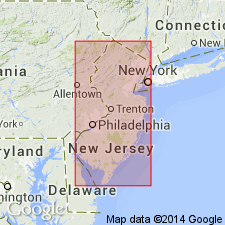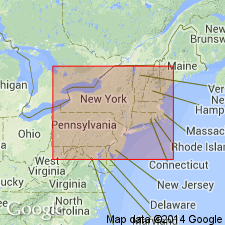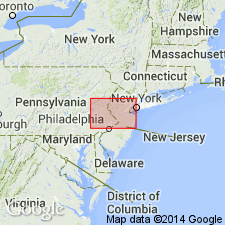
- Usage in publication:
-
- Feltville Formation
- Modifications:
-
- Revised
- AAPG geologic province:
-
- Piedmont-Blue Ridge province
- Newark basin
Summary:
A limestone-bearing sequence bearing a gross resemblance to a single Lockatong detrital cycle is named the informal Washington Valley member of the Feltville Formation. It consists of gray, black, and red siltstone and limestone with fossil fish, reptile footprints, carbonized plant fossils, and root zones, representing transgressive and deep water facies of lake bed deposits. It has been found in the southern Watchung and New Germantown synclines.
Source: GNU records (USGS DDS-6; Reston GNULEX).

- Usage in publication:
-
- Feltville Formation
- Modifications:
-
- Named
- Dominant lithology:
-
- Siltstone
- Sandstone
- Limestone
- AAPG geologic province:
-
- Piedmont-Blue Ridge province
- Newark basin
Summary:
Sequence of red siltstone and sandstone, buff, gray, and white feldspathic sandstone, and laminated limestone near the village of Feltville, NJ, is here named the Feltville Formation of the Newark Supergroup. This unit was part of the Brunswick Formation of Kummel (1897), which is here abandoned. The Feltville overlies the Orange Mountain Basalt and underlies the Preakness Basalt. Thickness is 60 ft (18 m) at type section, which represents about 15 percent of total thickness. Age is Early Jurassic.
Source: GNU records (USGS DDS-6; Reston GNULEX).

- Usage in publication:
-
- Feltville Formation
- Modifications:
-
- Biostratigraphic dating
- AAPG geologic province:
-
- Piedmont-Blue Ridge province
- Newark basin
Summary:
Age of the Feltville Formation is Hettangian based on spore and pollen assemblages.
Source: GNU records (USGS DDS-6; Reston GNULEX).

- Usage in publication:
-
- Feltville Formation*
- Modifications:
-
- Revised
- AAPG geologic province:
-
- Piedmont-Blue Ridge province
- Newark basin
Summary:
The Feltville Formation of Olsen (1980) is here accepted for use by the U.S. Geological Survey and is assigned to the revised Brunswick Group in the Newark basin in NJ. The Feltville is equivalent to strata overlying the Jacksonwald Basalt in PA, which are referred to as the upper part of the Brunswick Group.
Source: GNU records (USGS DDS-6; Reston GNULEX).
For more information, please contact Nancy Stamm, Geologic Names Committee Secretary.
Asterisk (*) indicates published by U.S. Geological Survey authors.
"No current usage" (†) implies that a name has been abandoned or has fallen into disuse. Former usage and, if known, replacement name given in parentheses ( ).
Slash (/) indicates name conflicts with nomenclatural guidelines (CSN, 1933; ACSN, 1961, 1970; NACSN, 1983, 2005, 2021). May be explained within brackets ([ ]).

